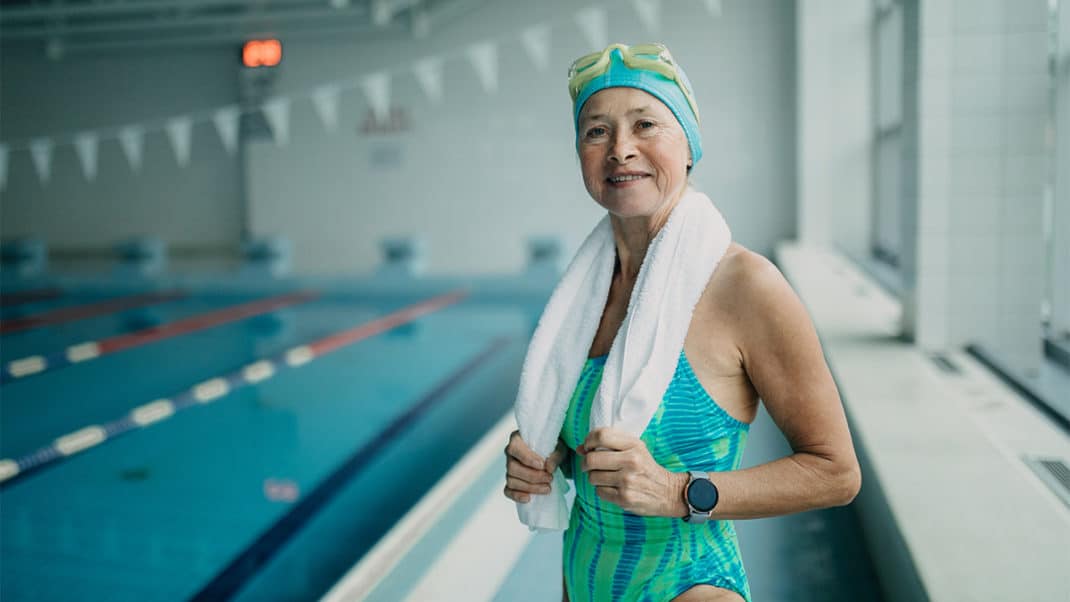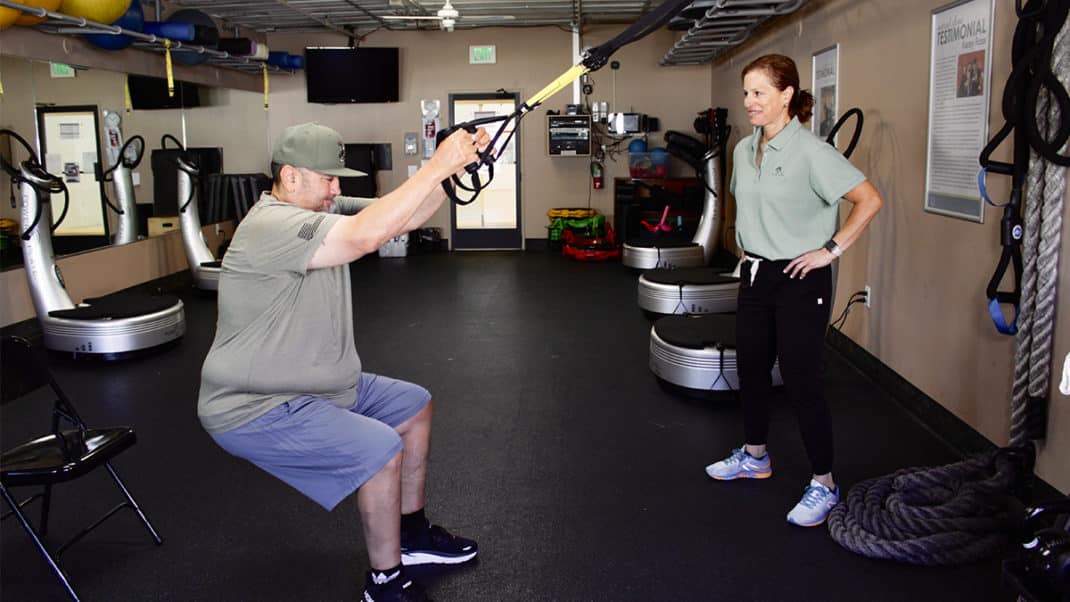Running for Life
When Hillel Katzeff signed up for a series of personal training sessions with IDEA member Crystal Powers, fitness and wellness director, personal trainer and group fitness instructor for the Lawrence Family Jewish Community Center in La Jolla, California, it wasn’t because he needed motivation to get fit. He had already spent a lifetime pursuing activity on and off the running track. What he needed, after years of painful struggle with psoriatic arthritis, was to regain the fitness level that would let him once again enjoy the thrill of competition.
Katzeff’s nickname growing up in Cape Town, South Africa, was “Speedy Gonzales.” “Running was my expression of freedom,” he says. As a teenager, Katzeff “won a fair share of titles” and designed his own training programs, focusing on sprints. After college, he moved to New York City to attend business school. It was during this time, at age 22, that he faced a major turning point.
“While jogging through the park one day, I noticed what felt like bone spurs in the heels of both of my feet,” Katzeff says. “Rest did not help. The pain not only continued but, curiously, spread to my fingers and toes. It was only after visiting four or five different doctors that I was diagnosed with psoriatic arthritis, a genetic condition that is incurable and can be triggered by stress.”
Katzeff tried to run through the pain, but eventually it became too much for him, and he put his running spikes in the closet. He attended support groups and tried to change his diet and lifestyle, but the pain was constant and sometimes overbearing. It “had a vice-like grip on me that I could not seem to loosen,” he said. “My energy was being sapped, and my motivation was at a low ebb. Mornings were the worst. It took me a few minutes of flexing my hands and feet before I felt like getting out of bed. My doctors called me stoic.”
Katzeff eventually took up swimming to help him stay in shape, which boosted his self-confidence. However, the pain was never far away. A breakthrough came during a regular visit to his doctor, when Katzeff received a prescription for a medication that, when combined with another, showed promise for people with psoriatic arthritis. He tried it and, within a few weeks, noticed a major change. “Instead of the pain continuously occupying a part of my brain, I now had free space to think about other things,” he said. “This was a new experience. It was the first time in about 20 years that I could say I wasn’t aware of constant pain.”
Katzeff, then aged 44, saw this as a unique opportunity to begin running again. But he didn’t want just to run for fitness; he wanted to compete in the men’s 100-meter sprint at the California State Games. “In my mind I was already running the race, but my body was definitely far from being in running—let alone, sprinting—shape,” he said. “I was unsure how my body would respond to the rigors of a full training schedule. I asked my doctor for his advice, and he said I should go for it—but that I should listen to my body. Yet, while my objective was to run in the race, my heart reminded me to stay true to myself and my mission: to take advantage of this window of good health, to get into better shape and to maintain it for as long as possible.”
This was where IDEA member Crystal Powers came into the picture. Powers had been leading classes, training clients and managing fitness programs since 1988. A former sprint runner herself who had special training in athletic conditioning, she knew the type of program Katzeff needed. Although he came to her with a large dose of will and motivation, he also presented quite a few challenges.
“He had a long list of injuries on top of his severe arthritis,” Powers said. “He was seeing a physical therapist and using other modalities to help him train. The medicine helped him go from barely being able to walk to being able to jog, but he still needed a targeted routine to help him reach his goal.”
Katzeff planned to participate in a pre-event warm-up race and had given Powers only 3 weeks’ lead time. “I didn’t have enough time to do any tapering,” she said. “We had to focus on strength. We did a lot of wall squats, lunges and calf work, but we avoided plyometrics at first because I was afraid he’d further strain his hamstring.”
Katzeff did end up straining his hamstring in the pre-event race, but he didn’t give up. After rest and rehab, he continued his work with Powers. “When he came back, his body was ready for more sport-specific training. We did a lot of plyometric work, bounding and working out of the block. We also did a video analysis and enrolled him in 2 days a week of yoga to help him with his flexibility, which improved immensely.” Powers worked very closely with the physical therapist.
Three days before the big race at the California State Games, Katzeff’s wife, Linda, became very ill, and his focus changed. The months of training and the race itself no longer seemed important. However, the crisis passed and she encouraged him to go through with the race. And so Katzeff made it to the starting block.
“I got off to a very good start and kept low during the first 20 meters before coming up into an upright running position in full stride,” Katzeff relates. “Being in a full sprint is controlled power. I felt the rush of air past my ears but was oblivious to the sound. My hands sliced through the air. Out of my peripheral vision I saw that I was among the leaders. I held my form. I pushed my body to its limit. With 10 meters to go, my hamstring pulled and I literally popped up and lost precious time. I toughed out the remaining three or four steps, finishing second with a time of 12.15 seconds.”
He did it! And his new window of health encouraged him to prepare for an injury-free season the following year. “I don’t know if the medication will lose its efficacy over time,” he says. “Right now, I am pain free. I am grateful. I feel blessed. I can only hope that the changes I have made to my lifestyle, maintaining a positive frame of mind and the advances of medical technology will help me stay a few steps ahead of [the pain].”
His personal trainer is as proud as can be. “When you work with someone who has this type of physical challenge and is still so passionate about reaching a goal, it makes you feel that you chose the right field,” Powers says. “He thanks me every time I see him, and I have to remind him that he’s the one that made it happen.”
Are your clients obese, disabled or just starting to exercise after years of sedentary living? We want to hear how you are motivating, challenging and retaining clients on a long-term basis. In 200 words or less, detail the specifics of your program and client[s], along with your name and contact information. If your success story is compelling and unique, we may use it in a future issue or on the Inspire the World to Fitness® section of the website.
E-mail: [email protected]
Mail: Sandy Todd Webster
10455 Pacific Center Court
San Diego, CA 92121-4339
Fax: (858) 535-8234
IDEA’s campaign unites our members with those of other organizations in a joint effort to reach out to nonexercisers. Our commitment is to provide you with information and sources so you can act locally.
Joy Keller
Joy Keller is the director of marketing communications & PR at IDEA, and has also served as executive editor of IDEA Fitness Journal, IDEA Fitness Manager, IDEA Pilates Today, and IDEA Fit Business Success. She is also a certified personal trainer, indoor cycling instructor and yoga teacher (RYT 200).






